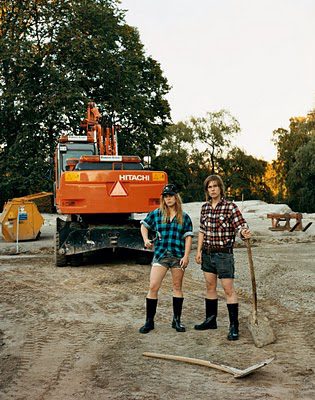Review by Rosa Rankin-Gee
There is something life-affirming about the queues to see art in Paris. Perennially long, and slow, and full of people complaining in a buoyant way. I was having a great time, until I realised I had actually joined the queue out of fondness rather than necessity, and was about to see Larry Clark at the Musée d’Art Modern for the second time in a week.
The Palais de Tokyo is just next door. Same egg-coloured building, different interior: hamster tubes, strip lighting and the famous fotoautomat. Fresh Hell sees the Palais give curation carte blanche to Adam McEwen, the New York-based British artist best known for his obituaries of the living, and turning chewing gum and text messages into artworks.
A privilege thus far only afforded to Ugo Rondinone in 2008 and Jenny Deller in 2009, the carte blanche is intended to map the artist’s brain, desires and influences. McEwen’s Fresh Hell is his dance through history, “unfettered” by chronology. Or, as it turns out, cohesion.
Visitors are greeted by three of the heads of the Kings of Judah, brutish 13th century relics lopped off the facade of Notre Dame by an angry mob during the Revolution. Directly behind them, the pointedly distracting backdrop of Rudolf Stingel’s tin foil wall, scratched with love hearts, and studded with paper planes and stabbed-in pens. The exhibition’s sense of self is perhaps clearest here: sabotage old and new, meaningful and less so.
Yet, also sharing the room is the cover image of the exhibition, Hanna and Klara Liden’s Sisters: two girls with thick knees and black rubber work boots. An arresting photograph, which deserves attention, it is out of sync with its roommates and thus nearly lost. This is characteristic of the show as a whole: it is a curiously strung necklace where mismatched beads weigh down the thread to breaking point.
Room two jerks us into Michael Landy’s Market, mini mountains of plastic crates draped with fake lawn carpets, a grocer’s market bereft of stock or customers. A statement about Thatcherism, the art market or economic recession, the 1990 installation (from the heyday, like many of the exhibits, of the YBA) declares itself ‘despairingly empty’, but this just seems like a perfunctory attempt to pre-empt criticism.
Fortunately, Hell gets a bit hotter with Anna Mendietta’s oddly touching self-portraits of her naked body straddling a skeleton, and Bruce Nauman and Frank Owens’ Pursuit, a film of 15 different people running, shot in disorienting, shaky-handed close-ups to a claustrophobic soundtrack of pounding feet and short breath.
Theoretically, the show skates through six stages: “genealogy”, “consecration”, “Danse Macabre” and “pilgrimage”, finishing with a dose of “mescaline” and finally “cemeteries”. These themes are borrowed from HC Westerman’s Connecticut Ballroom Suite, a bright and delicate sextet of woodcuts which nod to muralism, Dali and even Pop-Eye. Westerman’s six-piece Suite comes too late in the show however, and too understatedly, for its influence on McEwen’s curation to seem like anything other than a strapped-on afterthought. In fact, one theme, not six, emerges. The relentless runners, a transparent maze, a broken-into safe: futility is the order of the day. Sarah Lucas’s Is suicide genetic’ – a burnt armchair, throne to a motorcycle helmet made out of Marlboro Lights – neatly sums up the leitmotif.
In fairness, there are also moments of great playfulness (Barbara Bloom’s Playboy for the Blind: Marilyn Monroe seductively reading Ulysses on one page, a Braille description of the image on the opposite) and also fine workmanship. A late 15th century wood statue of Saint Florian, pin pricked with wood worm, is just beautiful. This is the problem: the water Florian pours onto a burning building is captured so well in wood that it makes one crave skill, and feel somewhat despondent about the ‘modern’ pieces that surround it. For example, Jessica Diamond’s Is That All There Is?, which poses the question atop a Clip Art image of the world, and Angela Bulloch’s flashing Belisha Beacons which are… exactly that, unadorned and unfortunately placed close to Martin Creed’s Work no. 925: 4 chairs, stacked together. Futility once again, and ferociously self-aware of course, but still, this is the type of art that won the YBAs their critics.
McEwen finds it exciting “when one work is allowed to generate friction with another.” Agreed. And flamboyant juxtaposition clearly lies at the heart of Fresh Hell. Yet there comes a point where ‘anarchic’ or ‘sprawling’ just become nice ways of saying ‘messy’ and, ultimately, ‘confused’.
McEwen’s only personal contribution to the exhibition comes very near the end. Hommage to Sigmar Polke – a scribble on the wall done with blue and cream masking tape which vaguely depicts a human form. Yes, there is certain irreverence, and a charm in the way the simple lines echo the cracks on the Palais’ shiny cement floor. However, like the overarching effect of the exhibition, it left me indifferent.
You exit the exhibition through Agathe Snow’s Yes, a wall full of a word which is perhaps deliberately inappropriate. Many will walk out of McEwen’s carte blanche with a question in mind rather than an answer: what Fresh Hell is this?
Rosa Rankin-Gee
Writer, and Editor of A Tale of Three Cities www.taleofthree.com, the first arts journal to join up the dots of London, Paris and Berlin, and Alight here: The Tube Project www.alighthere.co.uk
Fresh Hell contines at the Palais de Tokyo until 16 January 2011. www.palaisdetoyko.com
Image
Hanna & Klara Liden, Untitled (Sisters), 2006. Colour photograph, 101 x 76 cm. Courtesy of the artists.




